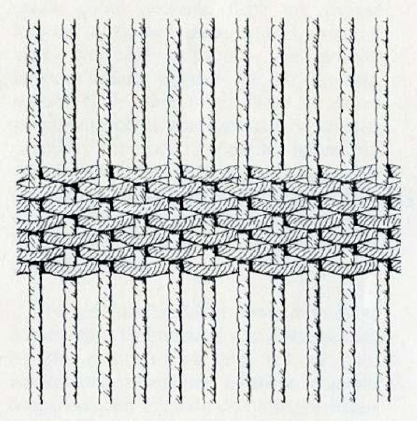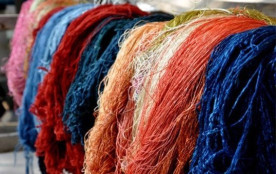Carpet Weaving Techniques:
There are two kinds of knots used in handmade rugs. The double knot, also known as the ‘Turkish Knot’ and the single knot, also known as the ‘Persian Knot’. Turkish Knot is a symmetrical knot and in Anatolia it is also known as ‘Ghiordes Knot’. Turkish Knot is used in rugs made in Anatolia, Caucusus, Azerbeijan and North East Iran. Turkish Knot is wrapped around two warp lines symmetrically, pulled out from the middle, tightened and the ends are cut. This way the knot is wrapped around two warp lines forming a solid structure.

Even when they get worn, handmade rugs that use the Turkish knot stay intact keeping the warp and the weft hidden under the knot. This way the colors and the motifs of the rug do not deteriorate for many years. The making of rugs using the Turkish knot takes a longer time compared to others due to the fact that tying the Turkish knot is harder. The Turkish knot does not come off because of its tight grip even if one wants to untie it. Antique Turkish Rugs that are hundreds of years old still preserve their colors and motifs to this day.
The single knot or the ‘Persian Knot’ is wrapped once around the warp string and the other end is left untied. This technique is asymmetrical. Persian Knot is used in rugs that are made in Iran, Central Asia, India and China.

Kilim Weaving Techniques:
Plain Weave
Plain weave tapestries are artistic objects that have a unique history and development. In several excavations in Anatolia woven tapestries dating back to 6500 BC were found. This proves that woven tapestries are much older than knotted tapestries.
Plain weave tapestries are woven on horizontal or vertical looms by threading the weft through the warp using different techniques. They do not have a pile due to the fact that they are woven.
Turkish Art of Kilims can be grouped under two main branches; geometric and natural designs. Kilims are the richest and the most colorful tapestries of Turkish weaving tradition. They are woven using various techniques and they are the most recognized type of Turkish tapestry all over the world. Kilims have traditional geometric motifs with nomadic roots.
Flat weave tapestries have never been thought of or produced as a commodity. It has been a part of communities’ everyday lives; made to be used by their makers and embellished with folkloric motifs to emphasize cultural highlights. Each kind of kilim bears symbols and colors important to their makers.

Turkic tribes that used to live in the vast plains of Central Asia continued their weaving tradition after they came to Anatolia. They have woven their symbols and colors significant to them thread by thread onto kilims reflecting the taste, talent and dexterity of Anatolian women for centuries.
Kilim motifs, compositions and colors have been transferred from generation to generation without major changes and they have survived to our day. Traditional kilims with geometric motifs are flat weaves that horizontal threads cover up vertical threads.
When weaving kilims strands of weft in different colors are threaded through strands of warp to form motifs. Strands of weft in different colors bring forth different kilim weaving styles depending on techniques used to weave them.

Sumakh Weave
Sumakh is a reverse weaving technique like jijim and zili. Motifs and patterns are formed by threading weft strands around every two strands of warp. Just like jijim weaving, the surface of sumakh weavings are bulgy. Threads form motifs by wrapping around the warp in areas where the patterns are intended to be formed. Sumakh weavings differ by the way motif threads wrap the warp and whether there are strands of weft in between them or not. Kinds of sumakh weavings are:
Flat Sumakh Weaving With Weft in Between
These weavings are formed by motif threads wrapping strands of warp. Motif threads are woven from top to bottom or bottom to top same in each line by taking on strand of weft between every two motif threads.

Reverse Sumakh Weaving With Weft in Between
Unlike flat weaving, motif threads are wrapped from inside to outside forming a thinner surface. It is not a practical weaving method. Since the look of the weave is ribbed it resembles the look of zili weavings and they are usually used alongside other weaving techniques.

Herringbone Sumakh Weaving with Weft in between
In this weaving, motif threads wrap strands of weft opposite each other. Because of its technique, the surface of this sumakh weaving is herringbone. Motif threads lean to the right on one line and to the left on the other forming the herringbone look. There is one line of weft between each two motif threads. We come across this technique on weavings made in West Anatolia, Central Anatolia, Taurus Mountains, Gaziantep and Malatya region.

Diagonal Alternative Sumakh Weaving with Weft in between
This is a weaving where each line of motif thread slides to the side. The first motif line is wrapped around two strands of warp and the second line slides to one side wrapping the consecutive strands of warp. Motif threads sometimes wrap 2 sometimes 3 strands of warp. This sumakh weaving technique is used while weaving tapestries, bags and sacks.


Flat Sumakh Weaving with no Weft in between Threads
This is a sumakh weaving that weft lines are not woven between motif threads. It is named as ‘sock weaving’ in some regions such as Malatya, Gaziantep, Diyarbakir, Elazig. Faces of sacks are generally woven using this technique. This weave can only be made by motif threads being woven around every double strands of warp. There are no weft strands between motif threads, the surface of the weave is quite bulgy.

Herringbone Sumakh Weaving with no Weft in between Threads
Motif threads are woven opposite each other. There are no weft strands in between motif threads, which gives the weave a ‘sock’ feel; since a similar technique is used in the weaving of socks. This weave is named as ‘sock weaving’ in South-East Anatolia.

Zili
Although these weavings can easily be mistaken for dense jijim weavings, they are made using a completely different technique. Zili weavings that are still prevalent in our day in nomadic villages are made by the motif thread being woven over 3 strands of warp and under 1 strand of warp.Once the row is completed the thread line is compressed down. When creating diagonal shapes the motif thread slides to the side in the consecutive line. Since the weaving technique is not very convenient, the motifs that can be woven are limited.
Flat Zili
Inside the motifs are filled by 2-1, 3-1 or 5-1 woven threads; meaning 2 over 1 under, 3 over 1 under or 5 over 1 under. Since the threads turn around at the end of each line by passing under two strands of weft in the perpendicular direction the weave has a perpendicular ribbed look. This weaving technique is called ‘ribbed’ in Antalya region. Cushions and tapestries with adjoining octagons, also called Turkmen rose, are frequently seen in Adana, Gaziantep, Kayseri, Nigde, Konya, Taurus Mountains and West Anatolia regions.

Diagonal Zili
Every motif thread jumps to the consecutive row diagonally leaving one unthreaded warp, forming a diagonal look all over the rug. Depending on the pattern they may be woven as fully diagonal, in opposite patterns forming large V’s or to form rectangles.

Sparse Zili
Flat cloth weaving comprises of small motifs that are woven 3-1 (3 over 1 under), 5-1 ( over 1 under) with flat zili weaving technique. These weavings that are made in the Taurus region between cities of Antalya and Silifke, the base weaving which are the warp and the weft are made of goat hair. In this region this weaving is named as ‘yoz’.

Chequered Zili
The motifs are formed by 2-1 (2 over, 1 under) and 3-1 (3 over, 1 under) patterns. This technique is generally used alongside other techniques. At times chequered motifs comprised of diagonal lines fill the base. Sometimes to fill the inside of motifs a chequered base is woven with the ‘counter zili’ also known as ’zili verne’ technique.

Counter Zili (Zili Verne)
This is a zili weaving made by the motif thread being woven 2 or 3 over on the base to create counter motifs. To make the counter motifs, after regular weft is woven the colorful thread woven from back to front moves 2-3 warp strands up. Then, it goes back on the consecutive row moving forward and 2-3 warp lines are woven. The motif thread on the front of the weave is held. When weaving the counter, the thread is woven back from the upper row. Only diagonal and perpendicular lines can be woven with this technique. Horizontal lines are formed by sumakh technique. The borders of motifs are the counters and the inside of counters are filled by sumakh or chequered zili.

Jijim
Jijim weavings are formed by colorful motif threads being woven between weft lines. The most common jijim weft is goat hair.
The technique used in the making of jijim weavings form bulgy motifs on the front side of the weaving. While forming the motifs, warp and weft lines follow a certain pattern. Once the weft is woven the motif thread is woven onto the base by skipping two or three warp lines depending on the desired motif. The motifs vary according to the width of the thread.
Jijim technique is used in the making of many different kinds of weavings. Bags, table cloths, bride sacks, cushions, pillow covers, bed spreads, prayer rugs and tapestries are made with this technique.

There are two common techniques when weaving with jijim technique.
Jijim Weaving skipping two lines
Motif threads are woven onto the base by skipping two warp lines. Depending on the motif the thread goes up straight, down straight or diagonally. Once the motif thread completes the line, weft line bordering the motif is woven. In jijims with a dense weaving this technique is used.
Jijim Weaving skipping three lines
In these weavings motif threads skip three warp lines. This weaving technique is also used in the making of dense textiles










